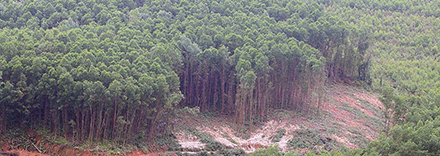In many locations where plantations have only recently been established little is known about the potential capabilities for increasing productivity as well as. We combine expertise in forest dynamics and management to understand productivity and carbon sequestration potential in Queenslands native forests.
The Outlook For Future Wood Supply From Forest Plantations
The optimal rotation ages with heavy thinning of Larix principis-rupprechtii and Pinus tabuliformis plantations are 48 and 49 years 78 years longer than what the current management regulation recommends.
Plantation forests productivity. Our extensive research database supports rapid assessments of potential forest and tree performance in space and time. Plantation forestry also must develop without adverse impact on the environment. Plantations must be developed with a balance between economic environmental and social goals.
For the first 44 years aboveground. These practices comprise mainly three forms. Afforestationreforestation practices are meant primarily to increase the supply of wood products in the country.
The forest sector employs 66 000 people directly and they support. Developing support systems for managing sustainable productive forests. FACTORS AFFECTING FOREST PLANTATION PRODUCTIVITY In this paper productivity will usually mean the cubic meters of harvestable wood that can be grown per year on a forested site.
A Decade of Research Partnership billion Rand. Thus forest plantations will have an increasingly significant role in substituting products from natural forests even if they cannot replace harvests from natural forests. Of this 81 came from exports and is equal to 73 of national GDP.
Together these trees form many millions of hectares of productive forest plantations far from their natural habitats. Shifting societal values such as safety productivity environmental quality and social are influencing the plantation forestry sector. This resource drove diverse forest product industries with an annual value of 133 billion Rand.
Industrial plantation periurban - energy forestry and small-scale plantations. Forest plantations can provide critical environmental social and economic benefits. Sustained productivity of plantation forests is the foundation of successful forestry which can provide diverse benefits.
Plantation forestry is new in many tropical areas and yields vary considerably across ecosystems Table 1. A simple simulation of global timber supply and demand allowing forest plantations and their productivity to extend at the current rate has shown that logging on natural forests could fall by half from about 13 billion m 3 in 2000 to about 600 million m 3 in 2025. Yields exceeding the latter are also reported.
During this phase there is potential for soil degradation but also opportunities to introduce sound new technologies to improve long-term productivity and soil properties. 236 Maintaining long term site productivity 25 237 Growth yield and rotation age 25 24 Forest plantation expansion 26 241 New areas available for forest plantation expansion 26 242 Stakeholder views on establishment expansion and improved manage-ment of forest plantations 26 243 Constraints and opportunities for plantation. Industrial-scale forest plantations require large capital investments and expertise in intensive management and environmental care.
While initial growth rates of plantation species were higher after four decades productivity of the natural regeneration plots was equal to or greater than productivity of the plantations. This is primarily driven through an ever increasing world population which in turn influences the way nations view the value systems by which they live. While the potential for achieving high productivity is recognised there are many constraints on yield.
Productivity not only covers harvestable wood but the quality of that harvested wood for various purposes. Productivity of plantation forests grown on short to medium rotations varies greatly from 1-2 m3 ha-1 yr-1to 25-30 m3 ha-1 yr-1. But it is more complicated than that.
Biomass and productivity were compared in two plantations and in one stand of natural regeneration on similar sites in a premontane moist forest region of Puerto Rico. Good management of this phase between harvesting and tree establishment in the next rotation is critical for the future outcome of plantations. But the productivity per ha per year of Larix principis-rupprechtii in the heavy thinning regime doubled to 821 m 3.
For example a decline in the productivity of key European plantation forest species such as Picea abies or Pinus pinaster is predicted due to a combination of rising temperatures and hydric stress at low latitudes and altitudes Lexer et al. Sustained Productivity of Plantation Forests in the Tropics. At the beginning of the twenty-first century forest plantations of all types probably amount to some 187 million hectares or about 5 of all forest cover in the world.
The impact of soil erosion by mass movement on forest productivity was investigated in a paired plot trial in a planted forest in a mainly hilly to steepland catchment Pakuratahi near Napier eastern North Island New Zealand. The total area of plantation forests in Ethiopia is estimated at 972000 ha. To do so however it is important that forest plantations be managed in accordance with a defined end-use objective.
Sound forest plantation management tree improvement and silviculture can sustain andor enhance productivity of forest plantations.



























